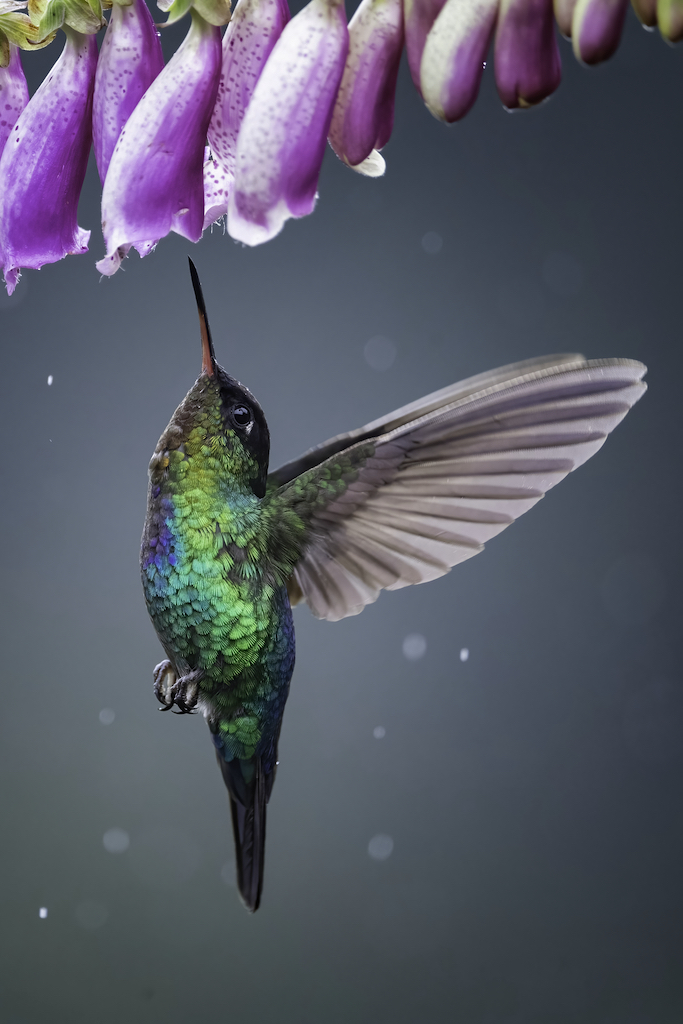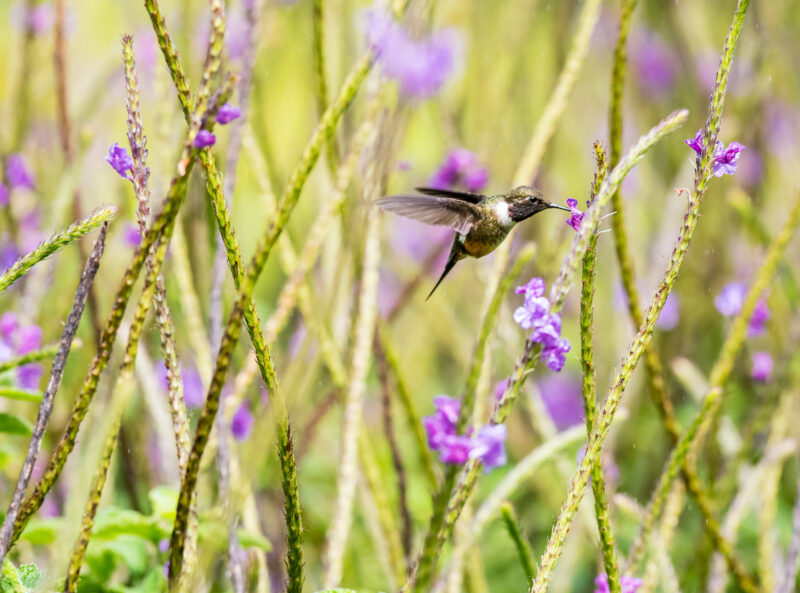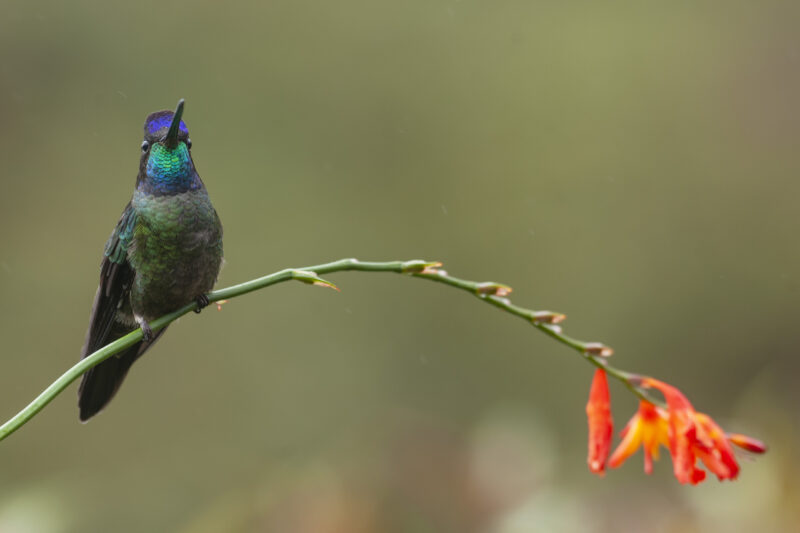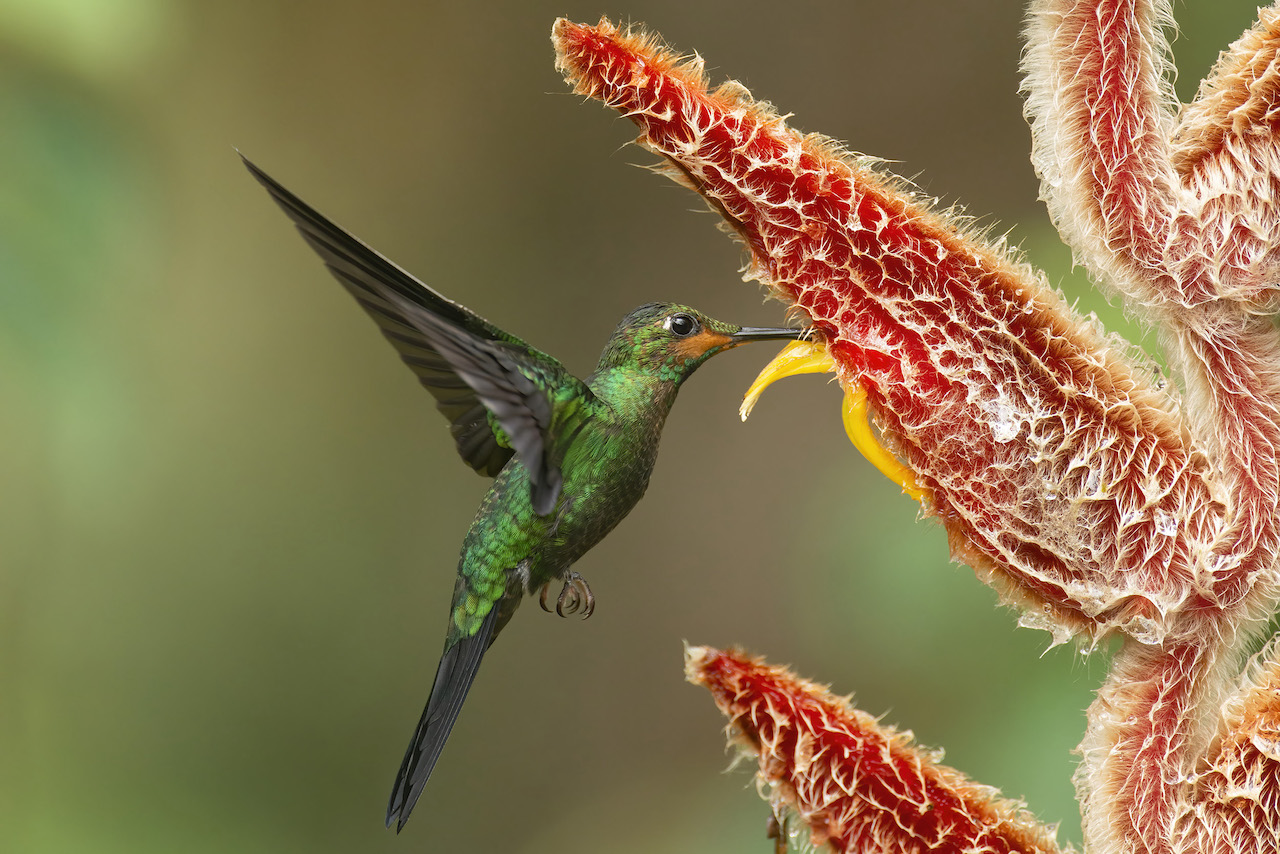The Wonderful World of Hummingbirds.
Cool facts.
Hummingbirds are the smallest birds in the world
For their size, hummingbirds have the largest heart & brains of all animals
Hummingbirds have no sense of smell
Hummingbird wings beat around 60 times per second
Hummingbird hearts beat from 500 to 1,200 times per minute
Hummingbirds are only found in North, Central, and South America
Hummingbirds visit 2,000 to 5,000 flowers a day
Hummingbirds can consume twice their weight daily
Their color is produced by the refraction of light, not by pigment
Their average speed is 45 miles per hour
Their tongues are twice the length of their bills
In addition to nectar, hummingbirds eat insects for protein
Hummingbirds cannot walk, only perch
Hummingbirds fly only 20% of the time
Courtship and Reproduction

Since hummingbirds are such competitive and solitary creatures, they are not lifetime maters. Hybrid mating is relatively rare among hummingbirds. The female often begins looking for the male once she has chosen a location for her nest and started to build it. Males attract females by posing, flying in particular patterns, and creating vocal and wing sounds. Sometimes they dive toward females, or fly back and forth before them, showing off the iridescence of their feathers.
The males also ‘possess’ territories rich in flowers and the females gain an ample food source in exchange for offering the male sole paternity rights. Intercourse is brief, though it may occur several times, but never for more than one day. The birds can actually mate while in mid-flight.
Once the act has been completed, the female hummingbird lays the eggs and then hatches them on her own. She usually chooses a location that is not in a most favorable feeding area, opting for peace and quiet, even if it means relying upon insects as the staple of her diet. The eggs are tiny, the size of jellybeans, and the average incubation is 16 days. Usually, only two eggs are laid, a day apart, and the mother uses techniques to warm and shade them to maintain a constant 90-degree temperature until they are ready to hatch. It takes more than three weeks for hummingbird babies to grow feathers and reach their adult size, while their bills get full size a bit later. At four weeks, the birds are ready to survive on their own.
Feeding Habits

Because hummingbirds have no sense of smell, they must find their food by sight. Young hummingbirds must learn to expect nectar from colored blossoms. Hummingbird bills are custom designed to match the shape and length of the blossoms from which they draw nectar. Bill shapes and lengths vary widely, but tend to be long and narrow, some being curved. Their tongues are twice as long as their bills.
The flowers hummingbirds use for nectar sources have evolved with them. To attract a hummingbird, a flower must be red, bloom in the daytime, be rich in nectar, and lack any sort of landing pad thereby eliminating competition from other birds. Flowers without landing pads are accessible only by hummingbirds, which can hover and feed while hanging in the air. Other flowers such as trumpet or tubular-shaped blossoms provide selective feeding for the hummingbirds since only the long, narrow bill of the hummingbird is able to access the succulent nectar.
Some hummingbirds feed from a single plant all day. Others have fixed feeding routes that cover large distances. They methodically fly in special patterns that define their territory. To survive, a hummingbird must consume more than its weight in food each day, which equates to between 6,000 and 12,000 calories per day. About 70% of this food comes in the form of liquefied sugar and the rest from insect protein.
A hummingbird’s diet consists of nectar, sap, and insects. If insects are available, a hummingbird may eat hundreds of them in one day, they may even raid a spider’s web to eat a captured insect or the spider himself.
Survival of Hummingbirds
Hummingbird survival skills must be learned by the new adults on their own, including flying, searching for food, avoiding predators, bathing, and grooming. Territoriality among hummingbirds can become a crucial, even violent issue. The birds will stake out an area of nectar-rich flowering plants and defend it vehemently by dive-bombing and occasionally stabbing rivals with their beaks. Predators include hawks, orioles, roadrunners, crows, jays, and other large birds. Mice and cats can also represent a danger to baby hummingbirds. There have been cases of attacks on tiny hummingbirds by praying mantises and tarantulas.
Sleeping Habits
Because hummingbirds have very little down and body fat, they must rely on their metabolisms to keep them warm. To protect themselves from lower temperatures at night, they go into a torpid state, meaning their normal body temperature of 86 degrees can drop to as low as 70 degrees, often matching the outside air. This ability allows them to conserve energy as their heartbeat slows from a daytime high of 1,200 beats a minute to 159 beats a minute.
Geographic Distribution

The 341 species in the hummingbird family, Trochilidae, are all confined to the Western Hemisphere. Their territory reaches all the way from South Alaska to the tip of South America, but most live along the equator in the rain forests of Colombia and Ecuador where flower nectar and insects are plentiful. Only 15 species of hummingbirds breed within the United States (most in western North America) and only the ruby-throated hummingbird is found seasonally east of the Mississippi. An increasing number of hummingbirds are beginning to winter in the southeastern United States, near the Gulf of Mexico.
Hummingbirds live at diverse altitudes, from the lowlands of the North American east coast to as high as 15,000 feet (4,572 m) in the Andes Mountains. Hummingbirds are not found in grassland plains, which lack sufficient nectar-bearing plants. Out of the 341 species of hummingbirds, 57 exist in Costa Rica.
Hummingbirds as Pollinators
Much like the bee, the hummingbird seeks nectar from flowering plants. During the process of extracting the nectar from the flower tube, pollen clings to their bill and feathers. As they visit different flowers of the same species of plant fertilization occurs and seeds are produced.

